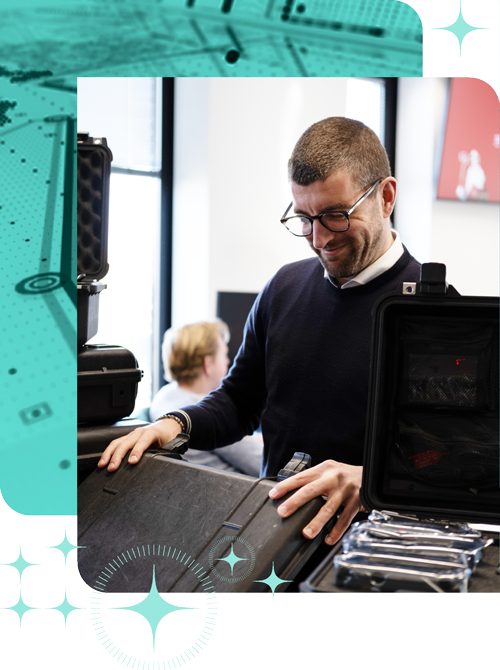Red Teaming

Adversary Simulation a.k.a red teaming
Train your organisation against your biggest cyber threats
We perform realistic simulations of cyber threat actors breaching their way to your organisation's crown jewels, with the goal to improve cyber resilience in terms of business, bytes and behaviour.
We provide you with clear countermeasures on an operational, tactical, and strategic level that reduce risks.
You gain insight into your vulnerabilities, how they can be abused by threat actors, what the impact can be and how to fix them.
Your blue team will get the most realistic training in responding swiftly and adequately to relevant cyber threats
Seamless integration with other Northwave services that improve your cyber resilience.
Our red team will put you to the test
Based on relevant threat-intelligence and trending Tactics, Techniques and Procedures (TTP's) used in the wild, our Red Team breaches its way to your organisations crown jewels. Don't be afraid, the simulation gives your organisation maximum insight of what it's like to be under attack by these threats, with the goal to learn and identify vulnerabilities. Our goal is to increase the cyber resilience of your organisation by improving your defences against these threats and helping you to adequately respond to them before they strike. Achieving this goal makes a Red Team Exercise successful.
At your request, we can also combine red team simulations with adversary emulation. By introducing actual tools of nation-state groups into your environment, we can quickly uncover gaps in your defences against the threat actors that matter most to you.

Service Options
Advanced Red Team Exercise
Red Team Exercise
Assumed Breach
Related Services
Managed Security & Privacy Office
Pentest
Managed Detection & Response
Vulnerability management
No resources?
Leave your Cyber security to us!
Frequently Asked Questions
We can imagine that you have many questions. You can always contact us to learn more. Below are a few examples of questions that we can investigate further with you.
When do i need an adversary simulation?
An adversary simulation is a broader and more comprehensive security exercise than a pentest. In contrast to a pentest, which is focused on one or more technical components, an adversary simulation involves your entire organisation from a business, bytes and behavior perspective. An adversary simulation typically involves simulating the actions of a real-world adversary and testing an organisation's defences against a range of relevant attack scenarios.
An adversary simulation is necessary if you want to train your specialists to defend your organisation against your biggest threats. Or if you want to gain insight into how vulnerable your organisation is to certain threats. Based on this security exercise, the cyber resilience and security posture of your organisation is measured, and the Northwave Red Team helps to make your organisation resilient. Your overall ability to detect, respond, and to recover from a cyber attack will increase.
How does an adversary simulation work?
Depending on your needs and the type of adversary simuklation being executed, we carry out the following phases.
Threat Intelligence: We obtain tailored threat-intel to identify your organisations threat landscape and build attack scenarios to be used in the next phases.
IN: Based on relevant attack scenarios, our red team operators try to obtain an initial digital foot in the door of your organisation.
THROUGH: Within your network, our red team operators move towards critical systems and processes, simulating the threat actor.
OUT: Through the critical systems and processes, our red team operators strike and obtain the crown jewels of your organisation.
Learning: After delivering an extensive report, Purple Teaming starts, with the emphasis on learning as much as possible from the simulation. broader and more comprehensive security exercise that involves simulating the actions of a real-world adversary. An adversary simulation typically includes a pentest as part of a broader set of activities, such as threat modeling, red teaming, and other techniques, that are designed to simulate the tactics, techniques, and procedures (TTPs) of a real-world attacker.
The goal of an adversary simulation is to provide a more realistic and comprehensive assessment of an organization's security posture.
What is purple teaming?
The adversary simulation ends with Purple Teaming. During a Purple Teaming session, your specialists, Northwave’s Red Team, and possible other stakeholders gather to share experiences, replay attacks scenarios, and work on improving monitoring and detection use cases. Purple Teaming is a proven and valuable method to really improve detection and response, increasing the cyber resilience of your organisation.
What is the difference between an adversary simulation and a red teaming exercise?
Adversary Simulation is also known as Red Teaming (synonym). They are a security exercise that involves simulating the actions of a real-world threat actor (the adversary) and testing an organisation's defences against a range of realistic attacks that this threat actor may conduct. The goal of an adversary simulation is to identify and assess the organisation's weaknesses, and to evaluate the effectiveness of its security controls and response processes, ultimately increasing the cyber resilience of the organisation.
We are here for you
Need help with your cyber security or wondering how secure your business really is?
Get in touch and we will help you find the best solution.
